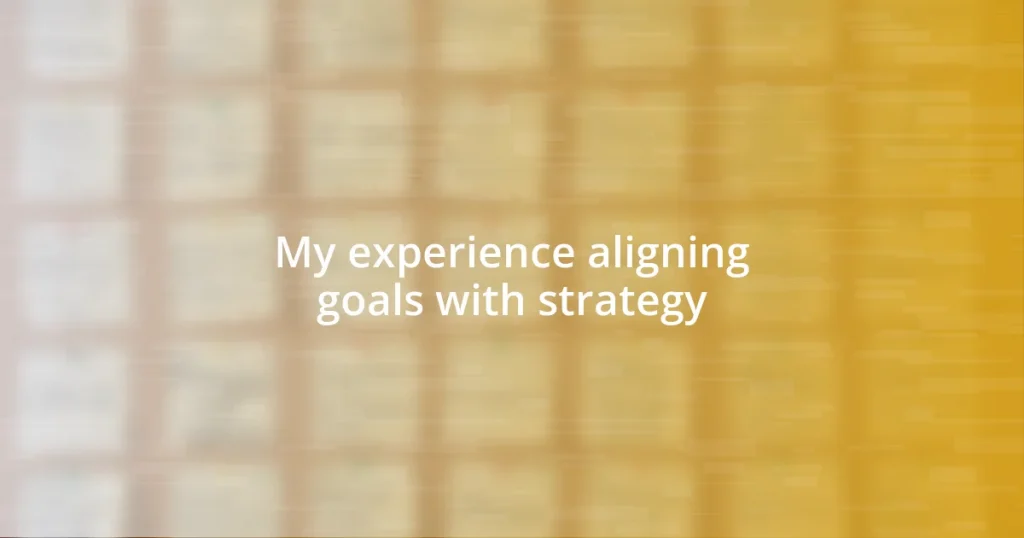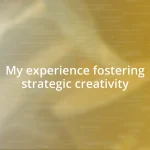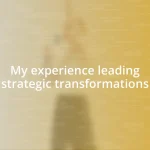Key takeaways:
- Aligning goals with strategy is crucial for creating clear direction, optimizing resources, and enhancing motivation.
- Utilizing tools like goal-setting software and regular check-ins can significantly improve strategic alignment and progress monitoring.
- Embracing flexibility, feedback, and collaboration fosters growth and ensures ongoing alignment with personal and professional goals.

Understanding Goals and Strategy
Goals are the end points we aspire to reach, while strategy is the roadmap that guides us there. I remember when I first set out to launch my own business; I had a vision but struggled to translate that into actionable steps. It dawned on me: without a solid strategy, even the most passionate goals can seem like mere daydreams.
One crucial aspect of aligning goals with strategy is understanding how they interact. Think about a time you aimed for something ambitious, like training for a marathon. Without a detailed plan—like a training schedule and nutrition guidelines—how could you hope to achieve that goal? That experience taught me how making a clear plan can transform overwhelming aspirations into manageable tasks.
I’ve also learned that flexibility in my strategy is just as important as having clear goals. When I faced unexpected challenges, like a shift in market demand, it became clear that I needed to adapt my approach. Have you ever found yourself at a fork in the road, needing to rethink your strategy based on new information? Embracing change not only helps in staying relevant but often leads to even better outcomes than I initially envisioned.

Importance of Alignment
Alignment between goals and strategy is essential for turning visions into reality. I recall a project where I was overly ambitious with my targets but didn’t fully align my strategy to support them. It was a tough lesson when I realized that my goals were reaching for the stars while my strategy was barely off the ground.
Here are some reasons why this alignment is so important:
- Coherence: When goals and strategy are in sync, it creates a clear direction for all involved.
- Resource Optimization: Proper alignment prevents wasting time and resources on activities that don’t contribute to the goals.
- Motivation Boost: I’ve found that when my strategy is aligned with my goals, my team feels more engaged and energized, as they can see how their efforts directly contribute to the bigger picture.
- Agility: With well-aligned goals and strategies, adjusting to changes in the environment becomes easier, allowing for quicker pivots without losing sight of the objectives.
Having experienced both the chaos of misalignment and the clarity that comes with it, I can confidently say that taking the time to ensure everything fits together is the key to success.

My Journey of Goal Setting
Setting goals has always been a journey for me, one filled with lessons and growth. I recall when I first tried to establish my fitness goals; I wanted to lose weight and build muscle, but the lack of a structured plan left me frustrated. Over time, I learned that breaking those overwhelming ambitions into smaller, more achievable milestones made a world of difference. Instead of focusing solely on the end result, I celebrated each pound lost and every new exercise mastered along the way.
Another pivotal moment in my goal-setting journey was when I decided to pursue a new career path. Initially, I felt lost amidst the overwhelming options; it seemed like I had too many goals pulling me in different directions. I remember sitting down one weekend, connecting the dots between my interests and potential career strategies. This reflective process not only clarified my objectives but also instilled a sense of purpose. I realized what truly mattered was aligning my passions with realistic opportunities.
I’ve consistently found that the emotional aspect of goal setting cannot be ignored. During a particularly stressful period, I set out to reconnect with my creative side through painting. At first, it felt like just another item on my to-do list, but soon it became a therapeutic outlet that energized me. This experience reinforced my belief that the process of aligning personal interests with clear goals is essential to maintain motivation and well-being. When your heart is in it, even the most daunting tasks can transform into enjoyable pursuits.
| Aspect | Experience |
|---|---|
| Initial Challenges | Felt overwhelmed by goals without a structured plan. |
| Realization | Breaking goals into smaller milestones made them manageable. |
| Career Shift | Connecting passions with opportunities clarified my objectives. |
| Emotional Journey | Pursuing a creative outlet turned challenges into enjoyable experiences. |

Tools for Strategic Alignment
One tool that has significantly helped me in aligning my goals with strategy is the use of goal-setting software. I remember when I first implemented a project management tool; it felt like unlocking a new level of clarity. By visualizing objectives through timelines and task lists, I could see what needed to happen at each step, making it easier to pivot my strategy when necessary. Have you ever felt lost without a clear path? I know I have, and these tools truly help bridge that gap.
Another practical method I’ve embraced is the use of regular check-ins and reviews. Believe me, dedicating time for a weekly or monthly reflection can be a game changer. I once neglected this practice, thinking I could self-manage effortlessly, only to find my strategy veering off course without my awareness. Now, those moments of pause not only allow me to assess progress but also reignite my connection to my goals. It’s refreshing to revisit what fuels my passion and adjust my approach accordingly.
Finally, I can’t stress enough the value of collaborative platforms for strategic alignment. Engaging my team on shared digital boards transformed our communication. I distinctly recall a brainstorming session where ideas flowed freely, and everyone had a voice. This collective effort not only brought diverse perspectives to the table but also fostered a sense of ownership. Isn’t it empowering to see how each team member’s contributions align with the overall vision? It’s moments like these that highlight the importance of tools in creating an inclusive, motivated environment.

Techniques for Effective Alignment
Aligning goals with strategy can be a nuanced process, and one method I’ve found invaluable is mind mapping. I often start by doodling my main goal in the center of a page and branching out with ideas and sub-goals. This visual representation not only sparks creativity but also helps me see how each part connects to the bigger picture. Have you ever felt overwhelmed by a goal that seemed too far out of reach? Mind mapping turns that colossal objective into smaller, manageable pieces right before your eyes.
Another technique I swear by is setting time-sensitive deadlines. When I first experienced project overload, I realized that tasks without deadlines tended to linger indefinitely. Now, I make it a point to incorporate short deadlines for even minor goals. For instance, I recently challenged myself to complete a personal project within two weeks, and the urgency propelled me into action. Isn’t it interesting how the ticking clock can serve as both motivation and accountability?
I’ve also discovered that surrounding myself with an accountability partner can change the game. I remember when a friend and I started checking in on each other’s progress with our goals. It became a source of support and inspiration, creating an environment where we both thrived. I found that sharing my challenges—and victories—made the journey feel less isolating. Don’t you think that having someone to share that burden (and joy) with makes the experience richer?

Measuring Success and Adjustments
Measuring success isn’t just about tracking numbers; it’s deeply about understanding progress and making necessary adjustments. I vividly remember the first time I set specific metrics to evaluate my goals. Initially, I was ecstatic to see positive growth, but when things stagnated, I was forced to reflect—what did success truly mean for me? It was through those uncomfortable moments that I learned to recalibrate my expectations and realign my strategy.
Regularly assessing my progress provided me with a clearer perspective. I still recall a quarterly review where I realized that one of my objectives had become misaligned with my overall vision; it felt like a lightbulb moment. Rather than feeling defeated, I embraced it as an opportunity to pivot. This experience taught me that success isn’t always linear and requires ongoing adjustments to stay in sync with my evolving goals.
There’s also something incredibly powerful about gathering feedback during the measurement phase. I remember inviting colleagues to share their observations on my performance, and their insights were surprising. It was like looking in a mirror; their feedback highlighted blind spots that I hadn’t considered. How often do we overlook the perspectives of others in our pursuit of success? Engaging with different viewpoints not only fine-tuned my strategy but also reaffirmed the importance of continuous improvement.

Lessons Learned and Future Plans
Reflecting on my journey, I realized that each setback actually served as a valuable lesson. For instance, there was a time when I poured my energy into a project only to find it didn’t resonate with my audience. That experience felt disheartening, but it pushed me to listen more closely to feedback. It became clear to me that embracing constructive criticism can be transformative, helping refine my approach and align my goals with what truly matters. Have you ever had an experience that made you rethink your strategy?
My future plans are firmly rooted in maintaining this growth mindset. I’m now committed to setting aside time for regular reflection. There’s something revitalizing about looking back on my progress and strategizing next steps. It’s like recalibrating a compass; staying aware of my motivations ensures that my goals remain relevant. Wouldn’t it be great if we all accepted that adjusting our course is part of growth?
As I look ahead, I’m excited about building an even stronger network of support. I’ve witnessed how sharing my journey with others enriches my experience. I’m planning to host regular goal-setting workshops with friends and colleagues. This idea stems from the realization that collaboration not only sparks new ideas but also solidifies commitments to our aspirations. Wouldn’t you agree that a supportive community can amplify our success?















